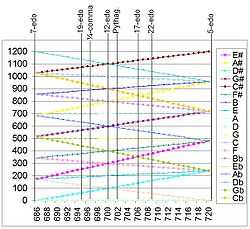Syntonic temperament
The syntonic temperament[1] is a system of musical tuning in which the frequency ratio of each musical interval is a product of powers of an octave and a tempered perfect fifth, with the width of the tempered major third being equal to four tempered perfect fifths minus two octaves and the width of the tempered major second being equal to two tempered perfect fifths minus one octave (i.e., half the width of the major third).
Alternatively put, the syntonic temperament:
- generates all non-octave intervals from a stack of tempered perfect fifths; and
- tempers the syntonic comma to unison.
This is the same definition as that of the meantone temperament. The syntonic temperament can be viewed as a systematic extension of the meantone temperament beyond the range imposed by the meantone temperament's need to remain consonant with timbres that conform to the harmonic series.

The syntonic temperament is named after the syntonic comma, as that is the first comma tempered to unison in its comma sequence.
Because it has two generators – the octave and tempered perfect fifth (P5) – it is a rank-2 regular temperament. Because one of its generators is the octave, the terminology of Erv Wilson would describe the syntonic temperament as a linear temperament.
If a two-dimensional arrangement of notes is generated using these same two generators, then it is an isomorphic keyboard, on which the fingering-pattern of any given musical structure is the same in any syntonic tuning. The combination of an isomorphic keyboard and continuously variable tuning enables Dynamic tonality, a novel expansion of the framework of tonality.[2]
As shown in the figure at right, the tonally valid tuning range of the syntonic temperament includes a number of historically important tunings, such as the currently popular 12-tone equal division of the octave (12-edo tuning, also known as 12-tone “equal temperament”), the meantone tunings, and Pythagorean tuning. Tunings in the syntonic temperament can be equal (12-edo, 31-edo), non-equal (Pythagorean, meantone), circulating, and closely related Just Intonation tunings.[3]
From the center of the syntonic temperament’s tonally valid tuning range, as the width of the P5 widens, the minor second narrows, eventually disappearing in 5-edo where it equals the perfect unison; as the width of the P5 narrows, the minor second widens, eventually equaling the major second in 7-edo.

The legend of Figure 2 (on the right side of the figure) shows a stack of P5's centered on D. Each resulting note represents an interval in the syntonic temperament with D as the tonic. The body of the figure shows how the widths (from D) of these intervals change as the width of the P5 is changed across the syntonic temperament's tuning continuum.
- At P5 ≈ 685.7 cents
 Play (help·info), the intervals converge on just 7 widths (assuming octave equivalence of 0 and 1200 cents), producing 7-edo.
Play (help·info), the intervals converge on just 7 widths (assuming octave equivalence of 0 and 1200 cents), producing 7-edo. - At P5 ≈ 694.7
 Play (help·info) (19-edo), the gaps between these 19 intervals are all equal, producing 19-edo tuning.
Play (help·info) (19-edo), the gaps between these 19 intervals are all equal, producing 19-edo tuning. - At P5 ≈ 696.8
 Play (help·info) (31-edo), a stack of 31 such intervals would show equal gaps between each such interval, producing 31-edo tuning.
Play (help·info) (31-edo), a stack of 31 such intervals would show equal gaps between each such interval, producing 31-edo tuning. - At P5 = 700.0
 Play (help·info) (12-edo), the sharp notes and flat notes are equal, producing 12-edo tuning.
Play (help·info) (12-edo), the sharp notes and flat notes are equal, producing 12-edo tuning. - At P5 ≈ 701.9
 Play (help·info) (53-edo), a stack of 53 such intervals - each just 3/44 of a cent short of a pure fifth - makes 31 octaves, producing 53-edo tuning.
Play (help·info) (53-edo), a stack of 53 such intervals - each just 3/44 of a cent short of a pure fifth - makes 31 octaves, producing 53-edo tuning. - etc....
- at P5 = 720.0 cents
 Play (help·info), the pitches converge on just 5 widths, producing 5-edo.
Play (help·info), the pitches converge on just 5 widths, producing 5-edo.
Research projects regarding the syntonic temperament
- The research program Musica Facta [4] investigates the musical theory of the syntonic temperament.
Notes
- ↑ Milne, A., Sethares, W.A. and Plamondon, J., "Isomorphic Controllers and Dynamic Tuning: Invariant Fingerings Across a Tuning Continuum", Computer Music Journal, Winter 2007, Vol. 31, No. 4, Pages 15-32.
- ↑ Plamondon, J., Milne, A., and Sethares, W.A., "Dynamic Tonality: Extending the Framework of Tonality into the 21st Century", in Proceedings of the Annual Meeting of the South Central Chapter of the College Music Society.
- ↑ Milne, A., Sethares, W.A., Tiedje, S., Prechtl, A., and Plamondon, J., "Spectral Tools for Dynamic Tonality and Audio Morphing", Computer Music Journal, in press.
- ↑ Musica Facta: http://musicafacta.org
| |||||||||||||||||||||||||||
